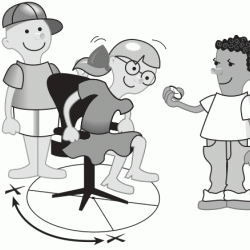Source Institutions
Source Institutions
Add to list Go to activity
Activity link broken? See if it's at the internet archive

In this activity, learners will perform various investigations to understand the vestibular-ocular reflex and learn about the importance of visual cues in maintaining balance. During the two-part activity, learners will compare the stability of a moving image under two conditions as well as compare the effects of rotation on the sensation of spinning under varying conditions. This lesson guide includes background information, review and critical thinking questions with answers, and handouts. Educators can also use this activity to discuss how the brain functions in space and how researchers study the vestibular function in space.
- 5 to 10 minutes
- 45 to 60 minutes
- $1 - $5 per group of students
- Ages 8 - 18
- Activity, Experiment/Lab Activity, Lesson/Lesson Plan
- English
Quick Guide
Materials List (per group of students)
- Pen or pencil
- Note pad
- Book
- Chair that rotates smoothly—preferably with back and arms, such as a desk chair
- Watch or clock with second hand
- One blindfold (optional)
- Protractor
- Chalk
- String or yarn (3 feet)
- Push pin
- Yard stick for drawing lines
- Activity Sheets
Subjects
-
Life Sciences
-
Human Body
- The Brain and Nervous System
- Health and Nutrition
-
Human Senses and Perception
- Vision
-
Human Body
-
Mathematics
-
Data Analysis and Probability
- Data Analysis
- Data Collection
- Data Representation
- Geometry
-
Measurement
- Circles
- Number and Operations
- Reasoning and Proof
-
Data Analysis and Probability
-
The Nature of Technology
-
The Design Process
- Problem Solving
-
The Design Process
-
Physical Sciences
- Vibration and Waves
-
Motion and Forces
- Gravity
-
The Nature of Science
- Science and Society
-
The Scientific Process
- Conducting Investigations
- Gathering Data
- Formulating Explanations
- Communicating Results
- Science as a Career
Informal Categories
- Physical Activity
Audience
To use this activity, learners need to:
- see
- read
- be mobile
- touch
Learning styles supported:
- Involves teamwork and communication skills
- Involves hands-on or lab activities
Other
Includes alignment to state and/or national standards:
This resource is part of:
Access Rights:
- Free access
By:
- MacLeish, Ed.D., Marlene Y. ; McLean, M.Ed., Bernice R.
Rights:
- Public domain, ,
